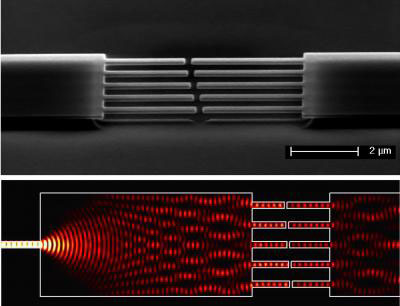Understanding Nanocantilevers: Essential Tools in Nanotechnology
Definition: Nanocantilevers are miniature, beam-like structures pivotal in the realm of nanotechnology and nanomechanical sensing. These devices, due to their incredibly small size, respond to minuscule forces and changes in their environment, making them indispensable for various high-precision applications, including biosensing, material science, and nanoscale surface analysis.

Principles and Mechanism
Nanocantilevers operate on the principle of mechanical displacement. When a force is applied to the surface of a nanocantilever, such as molecular binding or a change in temperature, the cantilever bends or deflects. This deflection is measurable and can be correlated to the magnitude of the applied force, enabling precise detection of chemical, biological, or mechanical changes at the nanoscale.
Construction and Materials
Nanocantilevers are fabricated from a variety of materials, each selected for specific properties that enhance performance and application suitability. Traditionally, silicon or silicon nitride has been the material of choice due to their well-understood mechanical properties and compatibility with semiconductor manufacturing techniques.
However, advancements in nanomaterials have introduced carbon nanotubes (CNTs) as a revolutionary material for constructing nanocantilevers. CNTs offer exceptional strength, flexibility, and electrical conductivity, making them ideal for applications requiring highly sensitive mechanical detection and electrical measurement capabilities. This diversification in materials allows for the production of nanocantilevers that are not only extremely thin and sensitive but also capable of detecting a wide range of forces and interactions at the nanoscale, from piconewtons (pN) to larger magnitudes.
Applications of Nanocantilevers
Nanocantilevers are not used in isolation but as integral components of sophisticated systems and devices across various fields. Here are some notable examples:
- Atomic Force Microscopes (AFMs): Nanocantilevers are crucial for imaging surfaces at the atomic level, providing insights into surface roughness, texture, and other properties.
- Nanoscale Mass Spectrometry: They measure the mass of tiny particles or molecules by detecting changes in resonance frequency due to particle adsorption.
- Chemical and Biological Sensors: Used to detect specific chemical compounds or biomolecules through changes in their mechanical properties upon interaction with the target substance.
- Nanomechanical Resonators: Employed in studying the mechanical properties of materials at the nanoscale and exploring quantum effects in mechanical systems.
- Optomechanical Systems: Integrated into devices that control light at the nanoscale for advances in optical switches, sensors, and quantum information processing.
- Environmental Monitoring Instruments: Utilized in real-time monitoring of air, water, or soil for pollutants, toxins, and hazardous substances.
- Nanorobotic Systems: Could play a role in the actuation and sensing mechanisms of nanorobots, requiring precise control at the nanoscale.
Advantages of Using Nanocantilevers
Nanocantilevers offer several advantages, including high sensitivity, minimal sample requirements, and the capability to operate in various environments (air, vacuum, and liquids). Their ability to provide quantitative data at the nanoscale makes them invaluable in both research and industrial applications.
Technological Advancements and Future Directions
Ongoing research focuses on enhancing the sensitivity and versatility of nanocantilevers, including integrating them with electronic and photonic systems for improved signal detection and processing. Innovations in materials and fabrication techniques continue to push the boundaries of their applications, from environmental monitoring to quantum computing.
Challenges and Considerations
Despite their impressive capabilities, challenges remain in the widespread adoption of nanocantilevers, including issues related to fabrication uniformity, sensitivity to environmental conditions, and the need for specialized equipment for measurement and analysis.
Further Reading
Microsystems & Nanoengineering, Artificial-intelligence-assisted mass fabrication of nanocantilevers from randomly positioned single carbon nanotubes
